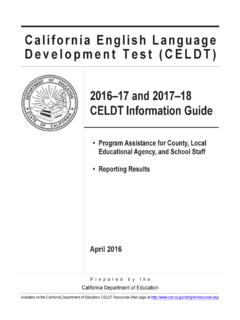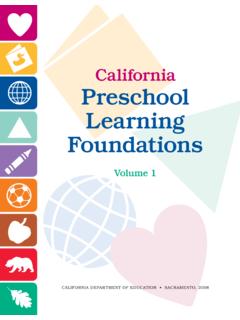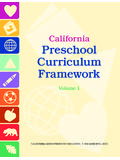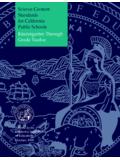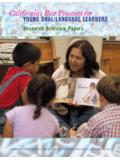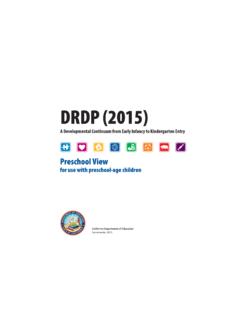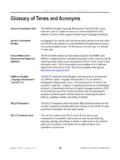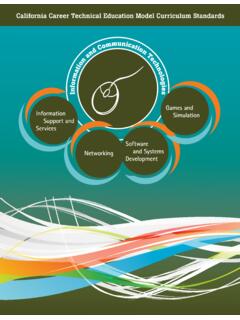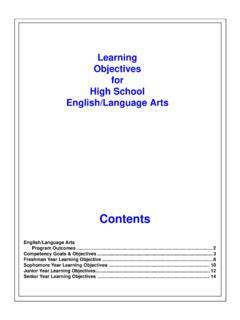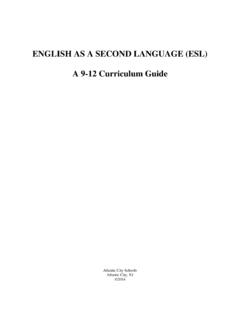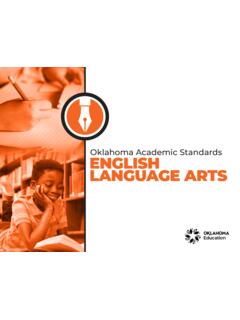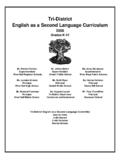Transcription of English–Language Arts A R D O F B O Content Standards D ...
1 ARDC alifornia Department of EducationCreated May 18, 2000BO O F EDUC Adopted by the of Education for California Public Schools California State Board December, 1997 english language arts Content Standards Kindergarten Through Grade Twelve english language arts Content Standards for California Public Schools Kindergarten Through Grade Twelve California Department of EducationCreated May 18, 2000iiCalifornia Department of EducationCreated May 18, 2000 Publishing Information When the english language arts Content Standards for California Public Schools, Kindergarten Through Grade Twelve was adopted by the California State Board of Education on November 14, 1997, the members of the State Board were the following: Yvonne W. Larsen, President; Jerry Hume, Vice-President; Kathryn Dronenburg; Marion Joseph; Megan Kephart; S. William Malkasian; Marion McDowell; Janet G. Nicholas; Gerti B. Thomas; Robert L. Trigg; and Marina Tse. This publication was edited by Faye Ong, working in cooperation with Greg Geeting, Assistant Executive Director, State Board of Education.
2 It was designed and prepared for printing by the staff of CDE Press, with the cover and interior design created and prepared by Cheryl McDonald. Typesetting was done by Jeanette Reyes. It was published by the California Department of Education, 1430 N Street, Sacramento, CA 95814-5901. It was distributed under the provisions of the Library Distribution Act and Government Code Section 11096. 1998 by the California Department of Education All rights reserved ISBN 0-8011-1389-9 Special Acknowledgment The State Board of Education extends its appreciation to the members and staff of the Commission for the Establishment of Academic Content and Performance Standards (Academic Standards Commission) for their outstanding work in developing and recommending the english - language arts Content Standards to the State Board of Education under the provisions of Education Code Section 60605. The members and staff of the Academic Standards Commission at the time of the approval of the draft english - language arts Content Standards were the following: Ellen Wright, Chair*; Bob Calfee, Vice Chair*; Joseph Carrabino; Judy Codding; Dan Condron; John D Amelio*; Linda Davis; Bill Evers; Andrew Galef; Jerilyn Harris; Dorothy Jue Lee*; Mark Ortiz; Judy Panton*; Raymund Paredes*; Alice Petrossian*; Kate Simpson*; Lawrence Siskind*; Larry Stupski; Jerry Treadway*; LaTanya Wright*; and Superintendent of Public Instruction Delaine Eastin and her designee, Sonia Hernandez.
3 Note: The asterisk (*) identifies those members who served on the Academic Standards Commission s english - language arts Committee. Special commendation is also extended to the leadership of Ellen Wright, Chair of the Academic Standards Commission; Scott Hill, Executive Director; Commissioner Alice Petrossian, Chair of the english - language arts Committee; and State Board of Education members Kathryn Dronenburg and Marion Joseph, whose significant contributions to the english - language arts ad-hoc committee deserve special recognition. Ordering Information Copies of this publication are available for $ each, plus shipping and handling charges. California residents are charged sales tax. Orders may be sent to CDE Press, Sales Office, California Department of Education, 1430 N Street, Suite 3207, Sacramento, CA 95814-5901, FAX (916) 323 0823. See page 86 for complete information on payment, including credit card purchases, and an order blank.
4 Prices on all publications are subject to change. A partial list of other educational resources available from the Department appears on page 85. In addition, an illustrated catalog describing publications, videos, and other instructional media available from the Department can be obtained without charge by writing to the address given above or by calling the Sales Office at (916) 445-1260. Notice The guidance in english language arts Content Standards for California Public Schools is not binding on local educational agencies or other entities. Except for the statutes, regulations, and court decisions that are referenced herein, the document is exemplary, and compliance with it is not mandatory. (See Education Code Section ) California Department of EducationCreated May 18, 2000 Contents A Message from the State Board of Education and the State Superintendent of Public Instruction .. iv Introduction .. v Kindergarten.
5 1 Grade One .. 6 Grade Two .. 11 Grade Three .. 16 Grade Four .. 21 Grade Five .. 28 Grade Six .. 35 Grade Seven .. 42 Grade Eight .. 49 Grades Nine and Ten .. 56 Grades Eleven and Twelve .. 66 Glossary .. 76 Selected References .. 84 iii California Department of EducationCreated May 18, 2000A Message from the State Board of Education and the State Superintendent of Public Instruction With the adoption of these english language arts Content Standards in 1997, California set forth for the first time a uniform and specific vision of what students should know and be able to do in this subject area. Reflecting a strong consensus among educators, these Standards establish high expectations for all students. They embody our collective hope that all students become effective language users so that they can succeed academically, pursue higher education, find challenging and rewarding work, participate in our democracy as informed citizens, appreciate and contribute to our culture, and pursue their own goals and interests throughout their lives.
6 Standards create a vision of a comprehensive language arts program. Before the creation of Content Standards , school reform efforts were guided by the desire to improve student achievement without agreement as to the Content of that achievement. These Standards set forth the Content that students need to acquire by grade level. At every grade level the Standards cover reading, writing, written and oral english language conventions, and listening and speaking. Grade by grade, the Standards create a vision of a balanced and comprehensive language arts program. Knowledge acquisition is a part of literacy development. Reading, writing, listening, and speaking are related processes, which should be nurtured within a rich core curriculum. Literacy competencies are the gateways to knowledge across the disciplines. Prior knowledge is the strongest predictor of a student s ability to make inferences about text, and writing about Content helps students acquire knowledge.
7 Thus, literacy and the acquisition of knowledge are inextricably connected. Educators should take every opportunity to link reading and writing to other core curricula, including history, social science, mathemat ics, science, and the visual and performing arts , to help students achieve success in all areas. Standards are central to literacy reforms. The Standards continue to serve as the centerpiece of language arts reform in California. They continue to provide a focus for the development of documents such as the Reading/ language arts Framework and literacy handbooks; criteria used for the selection of textbooks; the language arts portions of tests used in state assessments; and an array of professional development activities. Just as the Standards drive numerous statewide initiatives, they are also being used extensively throughout California as teachers and administrators strengthen local programs and create schoolwide literacy programs to meet the needs of all students.
8 Standards describe what, not how, to teach. Standards -based education maintains California s tradition of respect for local control of schools. To help students achieve at high levels, local school officials, literacy and library leaders, and teachers in collabo ration with families and community partners are encouraged to continue using these Standards to evaluate and implement the best and most powerful practices. These Standards provide ample room for the innovation, creativity, and reflection essential to teaching and learning. Standards help to ensure equity and access for all. The diversity of California s students presents both opportunities and challenges for instruction. language and literacy growth begins before children enter school as they learn to communicate, listen to stories, look at books, and play with other children. Students come to school with a wide variety of abilities and interests, as well as varying proficiency in english and other languages.
9 The vision guiding these Standards is that all students must have the opportunities, resources, time, and support needed to achieve mastery. Literacy is a gateway skill, opening a world of possibilities to students. Our goal is to ensure that every student graduating from high school is prepared to transition successfully to postsecondary education and careers. These Standards represent our commitment to excel lence for all children. RUTH E. GREEN, President California State Board of Education JACK O CONNELL State Superintendent of Public Instruction iv California Department of EducationCreated May 18, 2000 Introduction The english language arts Content Stan dards for California Public Schools, Kindergar ten Through Grade Twelve represents a strong consensus on the skills, knowledge, and abilities that all students should be able to master in language arts at specific grade levels during 13 years in the California public school system.
10 Each standard de scribes the Content students need to master by the end of each grade level (kindergarten through grade eight) or cluster of grade levels (grades nine and ten and grades eleven and twelve). In accordance with Education Code Section 60603, as added by Assembly Bill 265 (Chapter 975, Statutes of 1995), the Leroy Greene California Assess ment of Academic Achievement Act, there will be performance Standards that define various levels of competence at each grade level and gauge the degree to which a student has met the Content Standards that are measured. The Reading/ language arts Framework for California Public Schools (California Depart ment of Education, 1999) aligns the curricu lum and instructional program to the english language arts Content Standards . The framework serves as a guide for teach ers, administrators, parents, and other support personnel on when to introduce knowledge and how to sustain the practice of skills leading all students to mastery.
